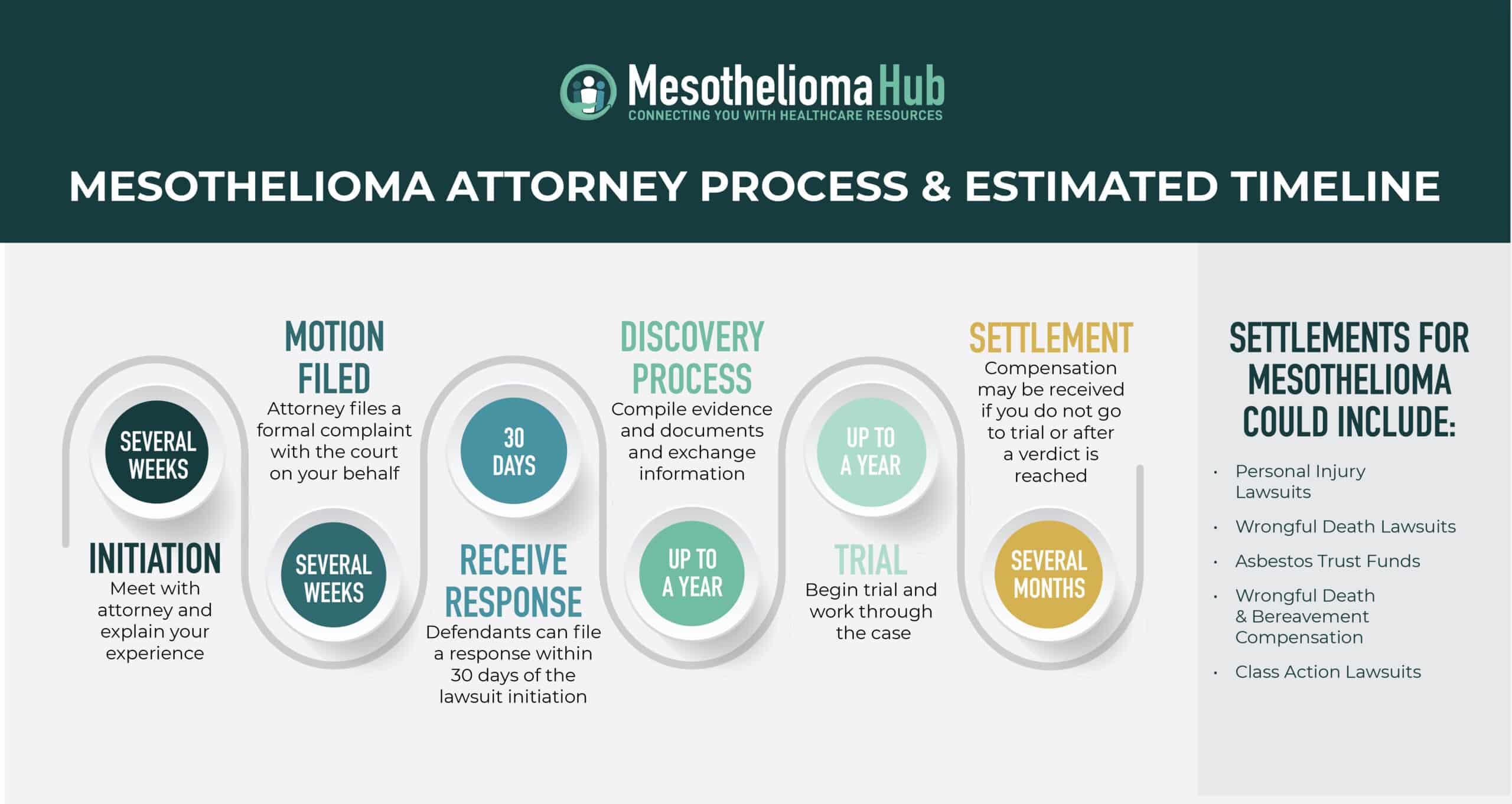Medically Reviewed by: Jonathan Sharp | August 26th, 2019
Mesothelioma lawsuits are typically governed by a time limit, and the case timeline can progress quickly if you’re not prepared. Once the statute of limitations begins, victims have only a few years to file a personal injury or wrongful death lawsuit. After hiring an experienced attorney, a mesothelioma case timeline will progress from initial interviews and gathering relevant documentation to eventually negotiating a settlement in court. The final step is receiving compensation but requires victims to learn about their legal options as soon as possible.

People exposed to asbestos have an increased risk of developing mesothelioma later in life and suffering devastating consequences including death. Unfortunately, most mesothelioma diagnoses are a direct result of negligent occupational asbestos exposure such as being underequipped or secondhand exposure. Victims and their families are typically eligible for financial compensation from companies that used asbestos or asbestos-containing products through a multitude of legal options. If you’re planning to file a claim for yourself or a loved one, it’s first important to understand the average mesothelioma case timeline and how long it takes for a mesothelioma claim payout.
After a patient receives a mesothelioma diagnosis, there is only a small window of time to file an asbestos lawsuit. The statute of limitations defines the amount of time a victim or their family has to file an asbestos case. The exact timeframe varies on a state-by-state basis. The process takes time, and it’s important to act quickly and meet with an attorney and explain your experience. Each phase of the process takes a certain amount of time to complete starting with a few weeks during “Initiation”, all the way up to a year for the “Trial”. What’s most important though is having a qualified and experienced attorney who can not only treat you to the proper legal council but can also connect you to the most experienced doctors in the field.
The mesothelioma litigation process doesn’t have to be complicated. If you’re well-prepared you can tackle the situation head-on and ensure an efficient outcome. There are a few steps each patient must take before receiving compensation, which includes:

Once you or a family member decides to file a claim, it’s time to find proper representation. Finding an experienced mesothelioma-focused attorney to represent you and navigate your case is extremely important, and will greatly affect your compensation decision. They’ll be the primary voice on the case, gather all appropriate documents, and even investigate the companies responsible for asbestos exposure.

Once you’ve found representation, it’s time to sit down and gather all available information. Your lawyer will assess the situation based on your health history, length of exposure, and medical diagnosis. They’ll advise you on the best way to move forward with your case since there are different types of claims to consider.

After you’ve discussed viable options with your attorney and decided what type of claim to file, it’s time to start gathering all relevant documentation. This includes your mesothelioma diagnosis and proof you were exposed at work. An attorney can help you secure this information.

Once you gather all the relevant documentation, it’s time to submit the claim. Legal venue, or where the claim is filed is also extremely relevant, as a case may be filed in one of several states based on numerous factors. Your lawyer will determine the most appropriate place to file your case.

The defendants, or companies responsible for your asbestos exposure, will receive a copy of the grievance and recruit their own legal counsel. They’ll have the opportunity to refute your complaint by collecting all the information they have on you, your employment, and health record. Typically, companies will deny all responsibility and claim the asbestos exposure happened somewhere else. This is the typical legal strategy and your attorney will be prepared for this.

This is also known as the discovery stage. Your attorney will start gathering all available evidence from the asbestos companies, and the defendant’s attorneys will also request information from you. They may ask about your illness or other relevant information to the case, and you may even be asked to give a deposition. A deposition is sworn out-of-court testimony that may be used at trial.

Cases only go to trial if a settlement agreement cannot be reached, but this rarely happens. Typically, the defendant won’t want a damaging verdict on their record, so the defendant’s attorney will make an offer. Both sides will negotiate back and forth until a settlement is reached. In the unlikely situation the case goes to court, you may have to testify about your illness and work history. The judge or jury will then make the final decision, or verdict.

It may take some time to receive compensation. There is always a possibility the defendant could file an appeal. This only happens if another court is asked to verify the legalities of the case, however, there’s only a short window, from 30 to 160 days to file an appeal. On average, patients will receive compensation from three months to one year. However, it may take longer in some cases.
If you feel like a family member or close friend may have been exposed to asbestos at work or home, then the first step to take is to initiate an interview with an attorney. There are many to choose from so it’s important that your legal council has experience in mesothelioma and asbestos cases specifically to ensure you receive the proper treatment. If you think that our expertise could be of assistance then you can learn more about our legal options and complete a free case evaluation form.
Jennifer Verta thrives as a digital content writer at Mesothelioma Hub. She has been producing content for clients since before she graduated from the University of Colorado at Denver with a Bachelor of Arts in Communication and a Minor in English Writing. Jen’s mission is to help promote awareness of mesothelioma to as many people as possible by providing only the most up-to-date and accurate content available. When she isn’t cranking the gears at work, Jen can be found snowboarding, hiking, catching live music, or socializing with friends.

As Director of Claims for the Environmental Litigation Group (ELG), Jonathan manages client relations as well as the collection and proper distribution of all funds. He’s been with ELG almost from the beginning and has been very involved in asbestos cases over the years. At ELG, the client always comes first, and Jonathan is able to address any concerns clients may have.
Consumer Notice. (2019). Mesothelioma Lawsuits. Retrieved on July 31, 2019, from https://consumernotice.org/legal/mesothelioma-lawsuits/
Harley, K. T. (2015). Mealey’s Litigation Report. Retrieved on July 31, 2019, from https://gnarusllc.com/wp-content/uploads/2016/07/ASB121615cm.pdf
Legal Information Institute. (2019). Deposition. Retrieved on July 31, 2019, from https://law.cornell.edu/wex/deposition
Rand Institute for Civil Justice. (2019). Asbestos Litigation. Retrieved on September 18th, 2019 from https://rand.org/well-being/justice-policy/centers/civil-justice/pubs/asbestos.html
Rand Institute for Civil Justice. (2005). Asbestos Litigation Costs, Compensation, and Alternatives.” Retrieved on July 31st, 2019, from https://rand.org/content/dam/rand/pubs/research_briefs/2005/RAND_RB9155.pdf